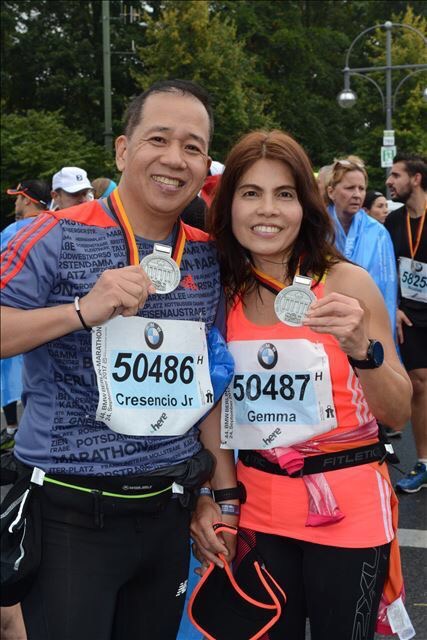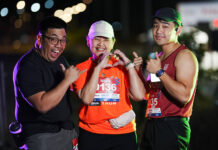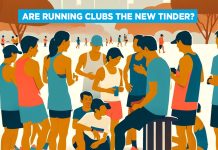
As I reached the 32nd-kilometer mark of the 44th Berlin Marathon last September 24, 2017, I instinctively checked my form, energy level, and emotion. At this juncture, this is supposed to be a wall. But there is no wall for me, not this time for my 1st marathon major.
Form-wise, I kept maintaining my mid- footstrike and a heads-up posture. On the energy level, I felt confident that I could last at least for 1 hour more of running. On the emotion part, I was ecstatic. I should be, as, at age 52, I was running my 4th marathon with my wife, Gemma, as we celebrated our 25 year wedding anniversary. Jubilation had been on the air from the starting line as strangers, event officials, and volunteers have cheered us all throughout.
To make the Berlin run more fulfilling, I finished sub 5 hours and thus improved my 2016 Portland Marathon feat. My wife also improved on previous marathon record.
With this backdrop, I wish to share some wits of wisdom about running, resolutions, fitness, and marathons. I believe that running should be fun, a means to celebrate and PB as well. As a disclaimer, I am not an expert on the subject, much less already an accomplished veteran. I took up running in October of 2014 before I turned 50, having been resolute to be fit at this mark. Hence, I know a few things about running, life, and the courage to start.
1. Start with something measurable for which you can be accountable.
New year resolutions do not work for me. In my younger years, I used to write that I wanted to be fit, healthy, and prosperous. I wanted to be good at what I do. With these broad goals, the horizon looked hazy still. Instead, through the years, by trial and error, and finding what worked best, I now know that my goals have to be specific, measurable, and inspiring.
Run three (3) times a week is a weak motivator for me. Train for a half-marathon or marathon is more specific and measurable
The distance is challenging that finishing it could be a milestone, especially if we PR. With these insights in mind, I began my journey from almost sedentary to a full-fledged marathoner.
When I trained for my first half marathon, the only distances I had covered were a 3k fun run and a 10K village run. Oh man, the goal was daunting. But mind you, we have to live fearlessly as Anita Moorjani, author of “ Dying to be Me” has advised. She should know as she was battling cancer but recovered remarkably fast after an NDE (Near Death Experience). With the mantra to live with courage, I then charted my goal and the time I needed to prepare for the 2015 Condura Skyway (half) Marathon.
2. Part of the training is becoming more knowledgeable about running.
We are born to run, Christopher Macdougal pointed out in his book “Born to Run.” However, if we wish to improve our running biomechanics and regimen, we have to remain open to new discoveries about our sport. We have to learn from the greats who ran before us.
Why would we run 400m repeats? 800m repeats? One day runs or two runs in a day? Threshold runs, fartleks, Tempo runs, or speed workouts? Knowing more about our hobby will make us more confident in our preparation. Also, the hobby becomes more enjoyable the more we understand it. Our vocabulary expands as well.
3. Run with passion and in the Flow.
Dean Karnazes, an ultramarathoner who ran 50 marathons in different US states for 50 consecutive days was once asked when he would stop running. His answer is enlightening- he would run so long as the passion is there. If there is no more passion for running, he said it would be time to stop.
Reflecting on his words, running is meant to be an enjoyable activity, not a chore nor an imposition.
Run if we must, but be mindful that we runners enjoy what we do, especially if we are training for a full marathon, which could take months. While we have different motivations, it is suggested that we move in the direction towards what brings us to a state of flow as described by Mihaly Csikszentmihalyi. He said “Flow is being completely involved in an activity for its own sake. The ego falls away. Time flies. Every action, movement, and thought follows inevitably from the previous one, like playing jazz. ”
4. Be courageous, but not silly.
I remember my first 10K run. It was a village run and it was meant to be fun. There were only two (2) distance choices, one 5k or 10K event. With some confidence that I could readily finish 5k, I opted to join the 10K event. Halfway through the event, I noticed that I was running neck to neck for the last place. I was panting and drinking lots of water along the route, which was gently sloping. Eventually, I finished the 10K run at last place, garnering the loudest cheers as the breakfast would not start without the last runner crossing the finish line. Whew!
The miracle is not in finishing the event, but having the courage to join the starting line.
I would not know if I could finish the 10K run if I did not start. The miracle is not in finishing the event, but having the courage to join the starting line. Be not afraid. Be courageous. But don’t do something ridiculous, such as opting to cover a challenging distance without adequate training and preparation.

Do I run to stay healthy or I am healthy, thus I run. There are as many appropriate mindsets as there are runners. Together with other workouts and protocols such as Intermittent Fasting (IF), running keeps me fit. It also quiets my mind. I am a morning runner, which usually starts at around 5 A.M. As the sun rises, I can smell the fresh breeze of the morning air, without yet the school buses and an early trove of vehicles on the road. The clue here would be what you find most pleasurable, convenient, and practical. It is even possible to do two (2) runs, one in the morning then late afternoon.
Do we run to lose ourselves or do we run to find ourselves?
Running is dual in character, a means to find ourselves amidst the chaos that life brings and an opportunity finds our true selves at the same time.
As an activity, it reminds us that we can muster the courage to live by choice, not by chance. We can choose to aspire and make changes, not resign to our circumstances and make excuses. We can opt to break from our cocoons to become butterflies, to be the best we can be, a personal best (PB).
Should we lace up or not? The choice is ours.
About the author:
Cris Aspiras is a partner of Aspiras & Aspiras Law Offices and a book author of “PDAF Controversy: For the Defense.” Outside the courtroom, he is an avid runner, having finished with a PR his 4th marathon, the 44th Berlin Marathon last 2017. He is married to a fellow lawyer and marathoner, Atty. Gemma Aspiras. They are blessed with four (4) children, all runners for fun.
Do you want to share your story? Email us at [email protected]








